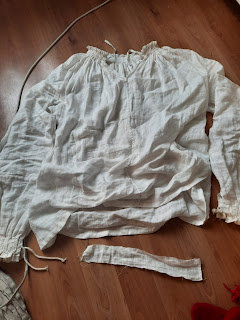When I planned to bring my fiancé to our 16th century guild feast the plan was to be indoors, so I figured it would be enough with a shirt and a pair of hose. Well with new covid regulations in place the feast was moved outdoors. And outdoors in Sweden in January meant that I needed to quickly come up with something that would keep him warm. I ditched the idea of making a pair of hose and instead decided to make a jacket, which definitely fits the challenge since it was made to protect from the cold.
First I needed some inspiration. I would not have time, or enough fabric in my stash, to actually make a proper 16th century jacket or doublet.
Looking at the images of a Swedish peasant army from 1502 it looks like a lot of them are wearing upper garments with fairly wide sleeves, a bit of a stand up collar and skirt under their breastplates.
I decided to go from there, and make something generic late medieval looking, rather than trying to get something totally accurate. The end result would be something fitting at a market or fair. As a start I took the pattern from my own historical jacket that I made last year.
 |
| My main jacket pieces |
Instead of the extra fabric to create pleats I cut the sideseam and back seams fairly straight and added gores there instead. Both to save fabric and to make it more medieval.
For sleeves I used my large s-sleeve pattern. For fabric I rummaged through my stash. I knew that I still had enough of this mottled black/grey wool, even if it's a modern fabric. I also found enough of a red wool flannell. This is the fabric that has really proved useful and I have gotten a gollar, a hood, a pair of hose and now a jacket out of it. There really is nothing left now. Just with my own jacket I wanted to make this jacket reversible so he would have a two in one jacket. The black and red fabric made this into a garment for someone richer than a peasant though, but I really didn't have anything else to work with.

For closure I went with cloth buttons and thread loops. This would make it easy to switch sides. The black fabric is very thin so I added a strip of sturdier wool on the inside that I added the buttons to. At this stage the fiancé wanted the black to be the outer fabric, so I sewed the buttons on to get them to be on the correct side when wearing the black as the outer fabric. But after having done that I felt that the red looked so much better, well, well. As I understand it the side to sew buttons on varied a bit in the middle ages as well.
The buttons sewed on on each side
Thread loops
The gores that were added at the back and side seams. I would have loved longer gores, but this was all I could get out from the fabric.
The finished jacket, and with the help of a belt it got a bit of skirt poofing out.
All in all I am actually quite pleased, and the double wool fabrics helped to keep him warm at our feast, so it definitely protected him.
The Challenge: Protection
Material: 2,5 m of red wool flannell, 2,5 of black suiting weight wool
Pattern: My own
Year: late medieval
Notions: linen thread, polyester thread
How historically accurate is it? 30% it is inspired and works as a generic late medieval jacket. The fabrics would only have been worn by nobility, and the main seams are made on the machine even if the visible seams are handsewn.
Hours to complete: 1 week
First worn: On a 16th century feast on the 22nd of Januar
Total cost: The fabric was pretty expensive when bought new so I guess around $70 if I had bought it today.































